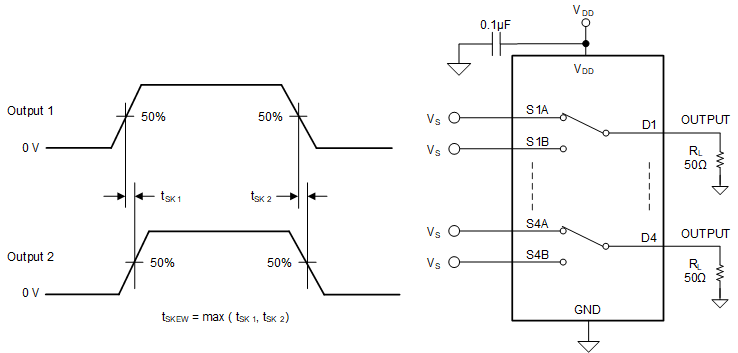SCDS391C October 2018 – December 2019 TMUX1574
PRODUCTION DATA.
- 1 Features
- 2 Applications
- 3 Description
- 4 Revision History
- 5 Pin Configuration and Functions
- 6 Specifications
-
7 Parameter Measurement Information
- 7.1 On-Resistance
- 7.2 Off-Leakage Current
- 7.3 On-Leakage Current
- 7.4 IPOFF Leakage Current
- 7.5 Transition Time
- 7.6 tON (EN) and tOFF (EN) Time
- 7.7 tON (VDD) and tOFF (VDD) Time
- 7.8 Break-Before-Make Delay
- 7.9 Propagation Delay
- 7.10 Skew
- 7.11 Charge Injection
- 7.12 Capacitance
- 7.13 Off Isolation
- 7.14 Channel-to-Channel Crosstalk
- 7.15 Bandwidth
- 8 Detailed Description
- 9 Application and Implementation
- 10Power Supply Recommendations
- 11Layout
- 12Device and Documentation Support
- 13Mechanical, Packaging, and Orderable Information
Package Options
Mechanical Data (Package|Pins)
Thermal pad, mechanical data (Package|Pins)
- RSV|16
Orderable Information
7.10 Skew
Skew is defined as the difference between propagation delays of any two outputs of the same device. The skew measurement is taken from the output of one channel rising or falling past 50% to a second channel rising or falling past the 50% threshold when the input signals are switched at the same time. Figure 36 shows the setup used to measure skew, denoted by the symbol tSK.
 Figure 36. Skew Measurement Setup
Figure 36. Skew Measurement Setup